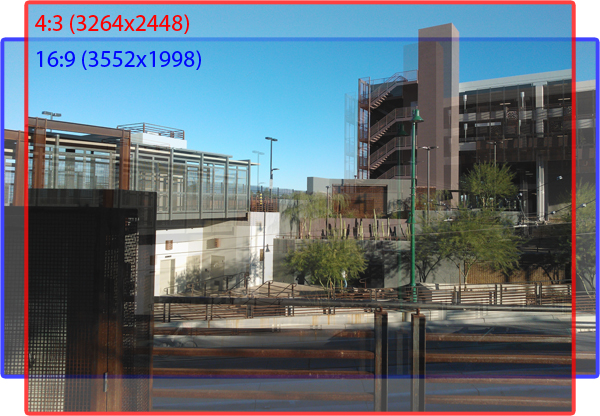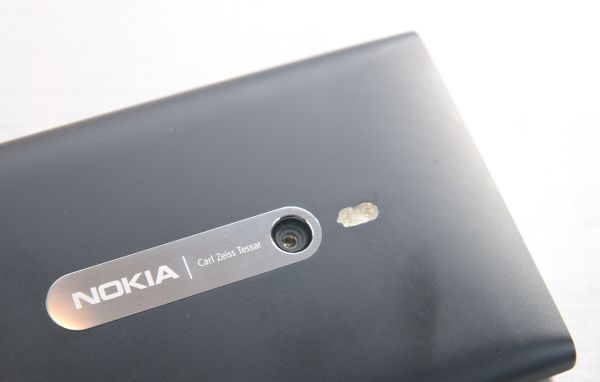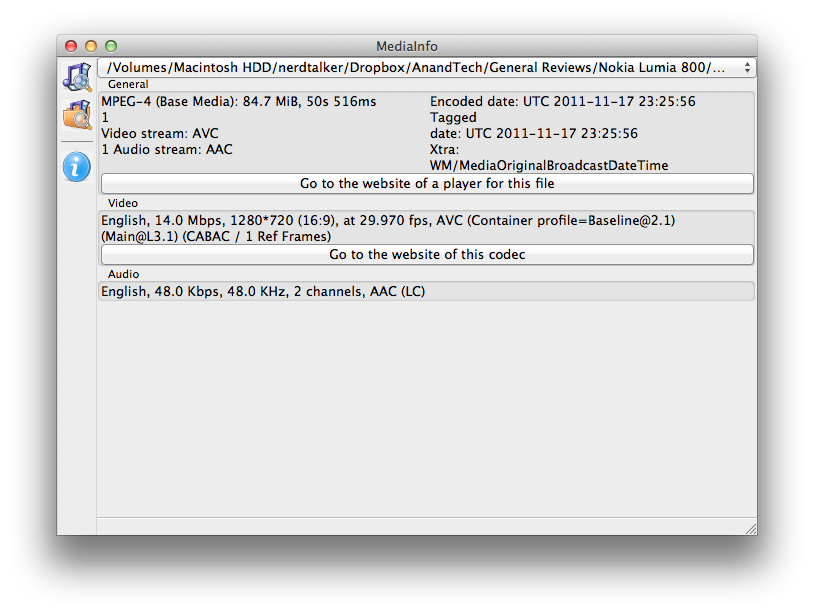Nokia Lumia 800 Review - Nokia's Brave New Foray into WP7
by Brian Klug on January 4, 2012 7:00 AM EST- Posted in
- Smartphones
- Nokia
- windows phone 7
- Mobile
- WP7
- Lumia
- Lumia 800
One of the big things people were alluding to when they talked about how much they wanted Nokia to make a Windows Phone was the camera. Though the other smartphone OEMs are fast catching up, Nokia still has something of a unique position in the smartphone camera world thanks to its positioning with Zeiss and long history of making devices literally built around their camera. In addition, WP7 puts some emphasis on the importance of the camera with their mandatory two-step camera button, and unfortunately until this generation many of the WP7 devices haven’t really shipped high-end cameras. I wager that many wanted the N8 camera in a Windows Phone, and though the Lumia 800 (and N9) don’t have that kind of design around the camera module, they don’t skimp either.
Before we go too further, let’s cover the logistics. The Lumia 800, like all Windows Phones, has a dedicated two-step camera button. It feels nice and clicky, and the two detents are easy enough to find and use. Nokia also locates its camera in the center of the device, which is unique and awesome for positioning the device with a tripod or mount - not a big thing for most users but still an intriguing choice. Since each Windows Phone can have different camera UI options it also bears going over those, and the Lumia 800 has more than most I’ve seen in a while. Shooting scenes, white balance, exposure offset, ISO, metering mode, contrast, saturation, focus (Macro or Normal), and resolution are all listed in still mode. Macro mode might sound a big confusing - this mode actually just gives you the full focus range (but as a result takes longer to run the AF routine) whereas normal has a more clamped range. WP7.5 also now saves and makes camera settings persistent after a close, something that was previously a big annoyance.
On paper the Lumia 800’s camera is definitely latest and greatest. It combines an 8 MP CMOS sensor that shoots stills of size 3264x2448 (4:3) or 3552x1998 (16:9) which is something we haven’t really seen before. Usually selecting a 16:9 shooting mode simply crops pixels off the top and bottom - on the Lumia 800, selecting this 16:9 mode does shave off some at the top and bottom, but gives you 288 more pixels in the horizontal direction and a truly wider field of view.

The only way I can see this being possible is that their CMOS really has an effective area of 3552x2448 (or slightly higher) and thus, both modes are a crop of that area. If you superimpose images from the two modes you can see that this is indeed the case (magnification remains the same). Nokia makes a big deal about this (as they well should) because it’s a pretty cool feature. As far as I can tell, the 8MP CMOS sensor’s size is 1/3.0” just like the N9. After a fair amount of digging, I tracked down that the CMOS sensor is “CMCS-85T330,” however this is an unfamiliar name to me. Based on the size and width, the pixels are no doubt in the 1.4µm class, however.
The Lumia 800 uses a Carl Zeiss branded optical system with an F/# of 2.2, which puts it in a small list of smartphones with F/2.2 optics. The camera module in the Lumia 800 is actually the same as the one inside the Nokia N9, and as a result performance differences between the two highlight the big differences in ISP between OMAP3 and MSM8x55. It’s difficult to know more about the intricacies of Nokia’s camera design, so I reached out on Twitter and learned that this design is indeed 5P (denoting 5 plastic elements) as opposed to the 4P that we’ve seen in many previous designs.
@nerdtalker lumia 800 is using a 5 element lens design.
— Damian Dinning (@PhoneDaz) November 8, 2011
On paper, the Lumia 800’s camera system is absolutely top tier, now the question becomes how it performs in our controlled and outdoor testing. To evaluate this, we turned to our lightbox tests with the lights on and off, outdoor testing at our test locations, and the new semi-revamped camera tests with the ISO12233, distortion, and color checker charts.
In the lightbox test with the lights on, the Lumia 800 is unsurprisingly very sharp. The small focus grooves on the Exakta are easy to make out and show very well. I think JPEG compression in WP7 or ISP might have been a bit aggressive here as the file is only 1.1 MB and shows some compression artifacts around lettering on the camera and other high spatial frequencies. The compression artifacts actually have the unintended consequence of somewhat masking sensor noise in the lights on test as well. The other complaint is that the image is very undersaturated and lifeless, unfortunately. I feel like this is some AWB issue since numerous other photos with the Lumia 800 not in a controlled box have great white balance. With the lights off (and using the dual LED flash) the Lumia 800 actually looks way more saturated and lively. WP7 also deserves lots of credit for always illuminating a dark scene during the autofocus routine, something so many smartphones still aren’t doing right.
The other controlled tests sort of tell the same story. The GMB color checker card looks a bit red, and a few other shots were blue of the same target. I don’t exactly have daylight color temperature bulbs or anything scientific for testing (yet) but this hunting around for proper white balance seems to be something specific to QCT’s SoCs still. Distortion is pretty low, again compared to SGS2 and some other culprits not a big deal at all. The ISO12233 charts also show that the Lumia’s camera (and by relation ISP and Windows Phone) don’t do absurd oversharpening like we’ve seen on some phones. We also see spatial frequencies on par with the other 8 MP shooters, though not much more. I can see up to the 14 line in the horizontal direction and 15 in the vertical before the contrast reversal. It’s clear to me at least that smartphone optical designs are obviously not diffraction-limited for obvious reasons.
It is in the outdoor scenes, the Lumia 800 really shines and starts to look a lot like the Nokia cameras of note we’ve seen before. Again we don’t have access to locations 1 or 2 anymore, only 3, 4, 5, 6, and 7 are refreshed. In addition, seasons changing makes getting the same lighting difficult. In virtually every scene the Lumia 800 has excellent sharpness and appearance. Only in test 7 is the Lumia 800 strangely bluer than most.
Unsurprisingly, the Lumia 800’s camera comes out looking very good against the rest of the 8MP competition, and for me this is the first F/2.2 8 MP shooter I’ve come across. With less compression and better ISP, it could be even better than most. Although I haven’t had a chance to test the N9, it would be interesting to see the differences that its very different ISP makes for.
Video
The Lumia 800 shoots HD video at up to 720p30 at 14.0 Mbps H.264 baseline. This is a pretty high bitrate for 720p and, despite being baseline CABAC with 1 reference frame, looks very good. It is a bit strange to see a super high end level smartphone shipping which only records up to 720p, but I’d personally take really good 720p over mediocre 1080p any day (just another place where looking only at video resolution can be misleading). This 720p limitation is no doubt a result of limitations imposed by MSM8255’s onboard video encoder, which to my knowledge can only encode up to 1280x720 H.264. The Windows Phone team likes to talk about how they don’t need the bleeding edge of SoC performance, but this is just another axis of improvement that isn’t strictly pure performance. Audio shot with the video is stereo AAC at 48.0 Kbps 48 kHz.
Oddly enough the Lumia 800 software defaults to shooting VGA unless you go in and select 720p instead. Controls here remain notably verbose, including most of the same ISO, exposure, and shooting mode options, in addition to continuous AF options.
As usual, we shot video using the phone under test at the our bench location and uploaded the result to YouTube and locally (89 MB) so you can watch without the YouTube transcode.
Given this bitrate and optics quality it’s unsurprising to me that the Lumia 800’s 720p30 quality is awesome. The video is sharp and subjectively looks awesome. In addition, its continuous autofocus runs quickly and without too much distraction. The Lumia 800 ends up falling into that category we talked about earlier of devices that don’t ship with 1080p video recording capabilities but instead deliver excellent 720p at a similar bitrate.
















































120 Comments
View All Comments
465thGTG - Wednesday, January 4, 2012 - link
Sounds like you aren't thoroughly familiar with Windows Phone. As far as performance goes, my Titan consistently feels faster and more fluid than my Galaxy S II, which has ungodly specs. Benchmarks may paint one picture, but real world use paints a completely different one.Speaking of the Titan, I can't believe Brian didn't mention it at all. Its camera is a clear step above both the Focus S and Lumia 800.
doubledeej - Thursday, January 5, 2012 - link
What evidence do you have for WP7 needing dual core? My HTC HD7 runs circles around my coworker's Galaxy S II with a lower clock speed and half of the number of cores.WP7 renders graphics using the GPU so everything feels fast and fluid. Android doesn't even attempt to do that until 3.0 (which isn't available on phones). ICS adds it, but not many models are getting that yet.
AMOLED is beautiful. Fully saturated colors and infinite contrast ratio. I'd take an AMOLED at half of the rated brightness of an LCD any day. The AMOLED screens in production aren't too dim. But some of the LCDs can get too bright.
french toast - Thursday, January 5, 2012 - link
I agree AMOLEDS are awesome!, i havnt seen a modern one but i saw my mates HTC desire when that came out and it was cool, if they have improved since then then i want one!I havnt used WP7 so i cant comment on responsivness, but what i will say is that multi cores devices actually bring the power consumption DOWN, whilst making something that can be multithreaded eg web browsing even smoother, it also gives games developers power to make better games, the GPU on the old snapdragon is weak, so while the OS may run smooth thanks to miccrosofts supreme optimizations,you cant tell me you wouldnt want better more powerfull engine inside, that gives better battery life as well as better games would you?
Either way, WP7 whilst clearly very slick, is selling like ice creams in antartica, and i think this has to do with the pecieved out of date specs, like NFC duel core LTE etc, people want the lastest gadgets with the same stuff there friends have..
Microsoft MUST start delivering some up to date hardware.
LB-ID - Wednesday, January 4, 2012 - link
Brian, just FYI. Article's last page, paragraph three:"at least min my mind"
I believe that should be: "at least in my mind".
Thanks for the article and analysis!
Brian Klug - Wednesday, January 4, 2012 - link
Fixed!-Brian
Brian Klug - Wednesday, January 4, 2012 - link
Thanks for all the edits/corrections everyone, I've made a number of changes (all those listed here). :)-Brian
comomolo - Wednesday, January 4, 2012 - link
I understand Nokia doesn't want the N9 to succeed or their Windows Phone strategy is doomed. But this is an independent news site, isn't it? Where's the N9 in the comparison charts? Where's the N9 review? Comparing the Lumia with the phone it inherited the design from (the N9) is only logical. Hiding it from your readers is not very professional.Yes, Nokia decided to "kill" Meego (that's just a public statement; it's obviously their "plan B" and will be the basis for their upcoming "low end" Meltemi), but for a whole lot of people who couldn't care less about "ecosystems" (which is just a new euphemism for "lock-in"), its applications offer is pretty nice. In some areas, like telephony, is much better than anything else on the market, and because it's fairly open, lots of hacks and community apps and add-ons are being developed every day. Honestly, unless you lack any knowledge of technology (and then, why would you want a smartphone?) the N9 is currently offering much better value than the Lumia or any other Windows Phone 7 device.
Belard - Wednesday, January 4, 2012 - link
I'm looking at jumping from Android to WPx... as it is, I am running the free WP7 Launcher on my Android that makes using the phone so much easier than the default Android one.I see postings from WP7 owners wishing the titles would rotate with the phone (As we know, not even iOS and Android does this)...
But there is the cool thing, the WP7 Launcher for Android *DOES* rotate the tiles - which not only looks cool, its handy and allows you to read the titles. Of course the wide titles can't rotate, but this function would SO be worth it.
Voldenuit - Wednesday, January 4, 2012 - link
Thanks for the great review!Minor nitpick, though. The F number by convention is reported as a reciprocal when used with lower case 'f', and as a normal number when used with upper case 'F'. It's just one of those weird notation conventions in photography.
Example:
f/2.0 == F2.0 == an aperture with a diameter half the focal length of the lens.
Camera geek with N8 in hand ;).
Solidstate89 - Wednesday, January 4, 2012 - link
If they could get that rumored Lumia 900 on Sprint with the 4.3" screen, I would finally be able to switch to a pure software keyboard. The keyboard WP7 uses is utterly fantastic, from its sound to its autocorrect. It's juts great. However on the 3.6" screen on my Arrive, it's a bit cramped even when in landscape mode. However something as large as 4.3" is certainly enough to make me move.